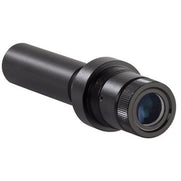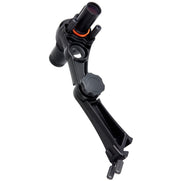Finderscopes Explained: Making Astronomy Easier and More Fun
December 23, 2024


What is a Finderscope?
A finderscope is a small auxiliary telescope or sighting device that attaches to your main telescope. It helps you locate celestial objects and align your telescope with precision. Thanks to its wider field of view, a finderscope makes it easy to scan the sky and find objects of interest before you take a closer look with your main telescope.
When you look through a finderscope, you’ll see crosshairs, circles, or a red dot that helps you center your target in its field of view. Proper alignment between the finderscope and the main telescope’s optics is key. The good news? Aligning your finder is easy and you can do it during the day. Once it’s aligned, your finderscope essentially becomes a mini version of your main telescope, allowing you to easily navigate the sky.
How to Use a Finderscope for Stargazing
Using a finderscope is simple. Start by moving your telescope roughly in the direction of your desired object—you can use a star chart or an astronomy app for guidance. Next, look through the finderscope and center your target in its field of view. Once it’s centered in the finderscope, you’ll see the same object through your main telescope, ready for you to view in full magnification.
Different Types of Finderscopes
Finderscopes come in various types, each with unique benefits for different observing preferences and styles:
- Red LED Finderscopes: These project a red dot or reticle onto a viewing screen, allowing you to aim with both eyes open and quickly align your telescope.
- Optical Finderscopes (Straight-Through): These are like mini telescopes that provide some magnification, helping you precisely aim at your target.
- Right-Angle Correct Image (RACI) Finderscopes: These finderscopes provide right-side-up, left-to-right corrected views, making them more comfortable for you to observe without straining your neck or back.
When selecting a finderscope, consider your telescope type, observing goals, and personal preferences.
Finderscopes on Celestron Telescopes
Most Celestron telescopes come equipped with a finderscope, except for the FirstScope series. Depending on your model, it will either have a StarPointer™ finderscope or an optical finderscope.
The Celestron StarPointer™ Finderscope
The StarPointer™ finderscope has 1x (no) magnification and offers a wide field of view, matching what you see with your unaided eyes. The red dot or reticle makes it easy to point to a target—just place the red dot or reticle directly over your object, and your telescope will be aimed at the right spot. You should know that Celestron finderscopes use an LED, not a laser, to create the red dot, so they are absolutely safe for the eye.
The Optical Finderscope
The Celestron optical finderscope is a small telescope with magnification that typically ranges from 6-10x and an aperture between 24-50mm. Straight-through optical finderscopes offer some magnification and invert the image you see, so objects appear upside down compared to your view with the naked eye. This isn’t a problem for astronomy, but it does take some getting used to. Due to their higher magnification and narrower fields of view, the optical finderscopes can be a little trickier to use, but help you more precisely aim at your target.
The Illuminated Right Angle Correct Image (RACI) Finderscope is another type of optical finderscope that displays right-side-up, corrected views and features illuminated crosshairs, making it easier to locate targets without neck strain.
Mounting and Compatibility
Telescopes using the StarPointer™ are equipped with a quick-release dovetail shoe or a small pedestal for easy mounting.
Telescopes that use the RACI or 50mm optical finderscope (like Schmidt-Cassegrain and EdgeHD) feature a two-piece bracket that allows you to easily detach the finder and its cradle from the permanently mounted base.
Whether or not you need to remove the finderscope when not in use will depend on the telescope model and how it’s stored.
































